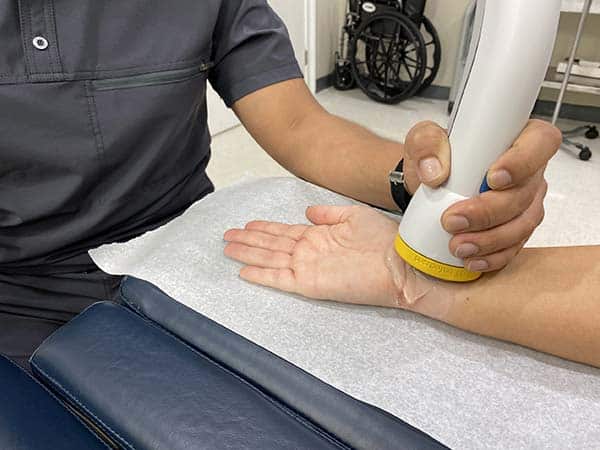
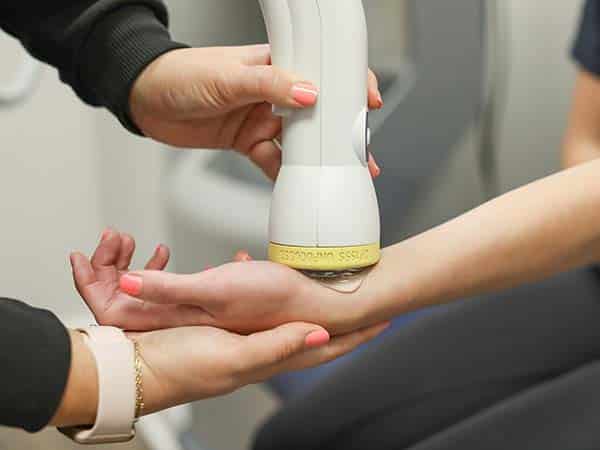
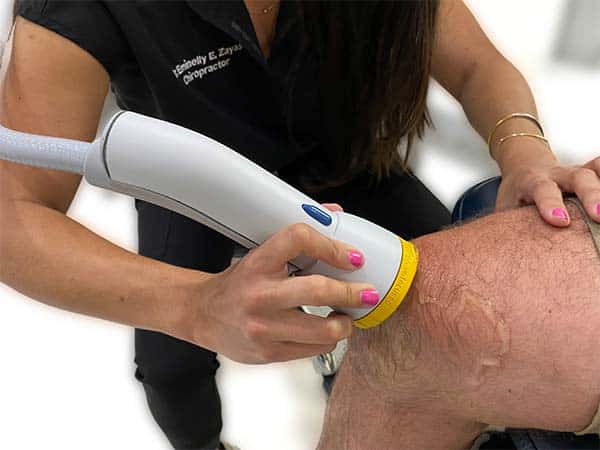
From serious sports injuries causing tissue damage to bone issues and stiffness that comes with age, living with pain is, well, a pain. But it's more than that - it's a stressful, often upsetting way to get through your day, month, and year. Have you ever tried to get out of bed with sore, stiff knees? Most folks would rather just get back in bed. Think you might try exercising with plantar fasciitis? Don't plan on running far or doing cardio for very long. Torn rotator cuff? Without proper treatment, your life might not ever be the same.
Living with pain and the inevitable issues that come with age can seriously affect your wellbeing and happiness. Sure, you could wake up every morning and rely on addicting medications to help you move. Or, you could risk further injury and damage with invasive surgeries that require long periods of recovery and downtime. But those can't be the only two options for treatment, can they?
Fortunately, a new, natural, non-invasive treatment for pain is revolutionizing the medical industry and transforming people's lives. It's giving athletes, average folks, and people of a certain age a reason to be hopeful. It's called Softwave therapy, and unlike many fly-by-night medications and sketchy treatments, it's backed by science and provided by Elite Healthcare Physical Medicine.
If you're barely making it through the day suffering from chronic pain, this FDA-approved drug-free treatment may be for you. Softwave therapy has already been used by thousands of people around the country living with issues like shoulder pain, knee pain, and plantar fasciitis. You could be next.
Though its popularity has only grown in recent years, Softwave therapy - also known as shockwave therapy - has been around for years. In fact, the first systematic study into the benefits of shockwave therapy took place way back in 1950. So, what is Softwave therapy?
Softwave therapy is a method of treatment that works incredibly well for mobility rehab, pain relief, and full-body recovery, usually from chronic pain or injuries. Softwave therapy uses a device emitting low-energy soundwaves that target a patient's injured area. These low-intensity waves boost blood flow and kickstart your body's natural healing processes, relieving long-term pain and helping your body to heal a wide range of injuries and conditions.
The main targets in the body include bones, tendons, and other soft tissues, which are encouraged to regenerate and repair via the shockwaves. Often, shockwave therapy is used in conjunction with other non-invasive treatments like chiropractic care, which we offer at Elite Healthcare Physical Medicine. The results are often incredible, leaving patients wondering why they never tried Softwave therapy before.
Softwave therapy works especially well for:

Better Blood Flow

Collagen Stimulation

Reducing Inflammation

Kickstarting cell growth and healing factors

Breaking down build-ups of calcium
With FDA clearance, little-to-no side effects, and quick application time, Softwave therapy is a welcome alternative for people suffering from pain. Who wants to spend weeks or months recovering from a surgery that might not even work? Likewise, who would want to become dependent on over-the-counter or, even worse, prescription pain meds? Living a life of addiction is a road nobody wants to go down.
Softwave therapy represents a revolution in non-invasive pain treatment; best of all, it's highly effective. Independent studies prove that shockwave therapy helps with pain. 65-91% of patients using shockwave therapy experienced real-deal improvements in damaged muscle and bone tissue, solving their mobility problems and drastically reducing pain. It almost sounds too good to be true, but as many patients at Elite Healthcare Physical Medicine will tell you - it isn't.
Book AppointmentSome of the most common conditions that Softwave therapy treats include:
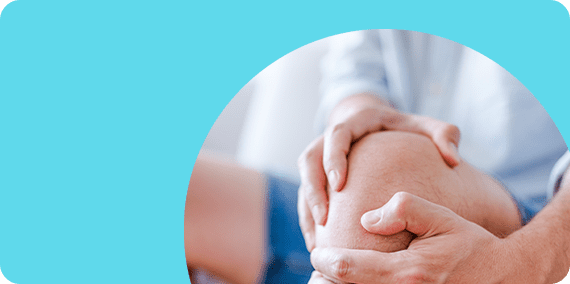


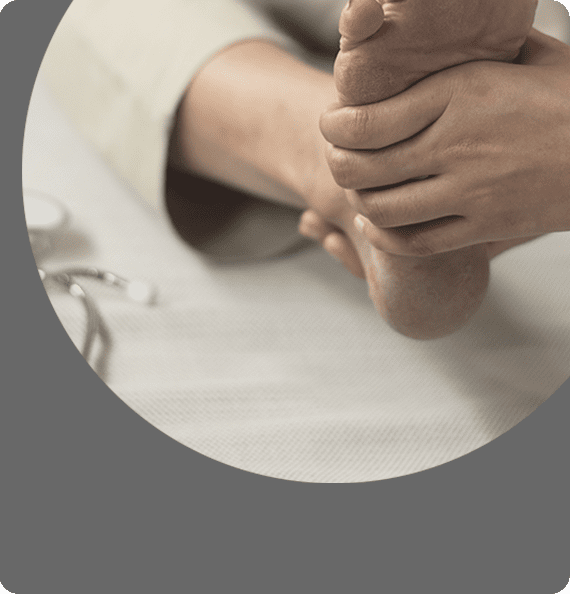

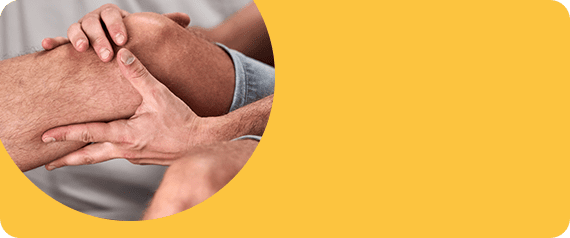
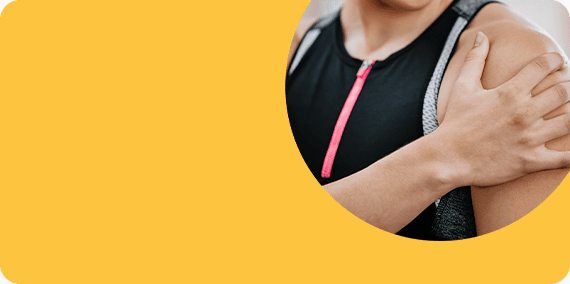

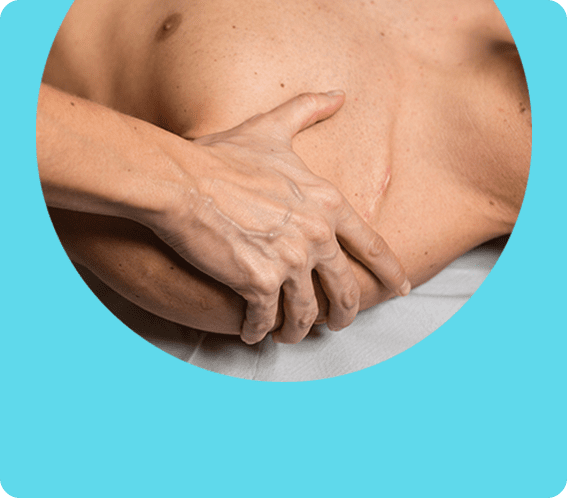
When you get up in the morning and go to the bathroom to brush your teeth, do you notice a stabbing, sharp pain near your heel? Does the pain go away once you have a chance to walk around? If so, you could have plantar fasciitis. According to the American College of Foot and Ankle Surgeons, this painful condition is quite common. About two million people suffer from plantar fasciitis every year, and almost 10% of all people will experience the condition at least once in their life.
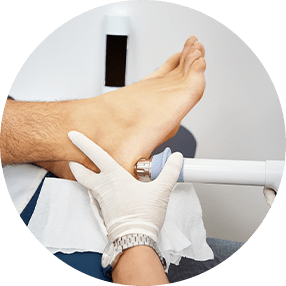
This common foot issue happens when the plantar fascia - a fan-shaped tissue near your heel - gets inflamed. The plantar fascia is a thick strip of connective tissue that links your toes to your heel bone, helping to preserve the arch of your foot. When this band is strained, it causes intensely sharp pain, usually in the morning when you wake up and plant your feet on the floor.
Most folks ignore plantar fasciitis because the pain eventually goes away throughout the day. However, if left untreated, plantar fasciitis can lead to weakness and chronic pain, which may affect daily walking.
Some causes of plantar fasciitis include:
The short answer to this question is not really. Patients with plantar fasciitis will ice the affected area with little-to-no relief since they spend so much time on their feet. It's hard to rest an achy heel if you've got a job that requires you to be on your feet. Anti-inflammatory meds like Advil don't work all that well, either. They may provide temporary pain relief, but in terms of a long-term solution, taking these drugs will cause major side effects.
Book AppointmentWhen more conservative treatment options like ice and over-the-counter meds don't work, most doctors turn to ultra-expensive orthotics, steroid injections, or invasive surgery. For the average person, those options fail on all fronts, as they carry risks for side effects and may even cause the issue to worsen.
Instead of going under the knife or changing their daily routines, many people suffering from plantar fasciitis are turning to Softwave therapy for relief.
During a shockwave therapy session, our expert providers use a special probe to deliver pressure waves to inflamed tissue. These waves trigger natural healing processes causing new blood vessels to form. In turn, oxygen is supplied to the affected area, reducing inflammation and causing healthy cells to regenerate. Shockwave therapy also produces collagen, which is crucial for connective tissue health.
With just a few visits, many patients find long-term relief from plantar fasciitis without relying on strange drugs or harmful surgeries.
Living with knee pain is just miserable. From knee tendonitis to osteoarthritis, knee pain can prevent you from enjoying activities and affect your day-to-day life. Your knee is a joint comprised of cartilage, bone, ligaments, and fluids. Tendons and muscles within the knee help the joint move. When one of these crucial knee structures is hurt or compromised, it results in knee pain and long-lasting knee problems. This, in turn, leads to difficulty walking at best and debilitating knee issues at worse.
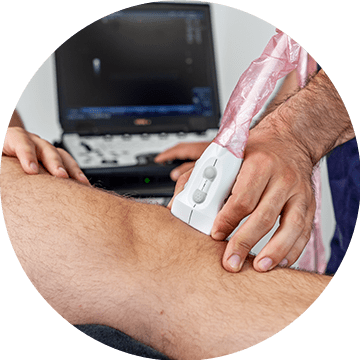

If you're an active person or somebody who plays sports often, you're probably all too familiar with knee pain - especially common conditions like patellar tendinopathy. Also called "jumpers knee," this issue happens at the patellar tendon, which is found on the front of the knee just under the knee cap. When living with this condition, most patients experience pain around the kneecap or lower down on the leg around the tibia.
In addition to injuries and issues like jumper's knee, everyday wear and tear will cause knee pain over time. With time, this knee pain can develop into arthritis. If your knees are swollen, painful, or stiff, you may have arthritis in your knees. Regardless of the kind of knee pain you're experiencing, treatment options have been limited to agonizing surgeries and addicting pain medications. But that all changes with shockwave therapy for knee pain in McClellanville, SC.

Though no two knee pain problems are exactly the same, shockwave therapy has been shown to be highly effective for knee pain. In fact, many patients at Elite Healthcare Physical Medicine find relief after just one session. Many times, sessions can be completed in as little as 30 minutes. So if you want to find relief for knee pain on your lunch break, that's definitely possible.
As is the case with plantar fasciitis, Softwave therapy works by sending sound wave and low-energy impulses to the affected area of your knee. These pulses stimulate your body's healing factors, which can help regenerate and repair damaged tendons and tissues. Softwave therapy for knee pain is especially promising for people who have tried other treatments - like surgery and pain meds - with disappointing results.
Benefits include:
Several studies and reviews prove that Softwave therapy can be very beneficial for people suffering from knee pain problems like jumper's knee. A study involving 66 patients with knee pain found that they enjoyed a significant improvement in their reported pain levels with Softwave therapy. In fact, knee pain was reduced by nearly 50% after a single month. When combined with other regenerative and physical therapy treatments at Elite Healthcare Physical Medicine, your days of living with knee pain are numbered.
Book AppointmentHere's a fact for you to consider: Every joint that you have in your body plays a part in your day-to-day life. But when we think of joint issues, we typically jump to knee issues. However, your knees aren't the only joints in your body to go through wear and tear. Your shoulders experience just as much, if not more, wear and tear than your knees. We put a strain on our shoulders just about every time we use or move our arms. Our shoulders play a pivotal part in living a normal life. When they begin to deteriorate over time due to age or overuse, it creates a litany of painful problems.
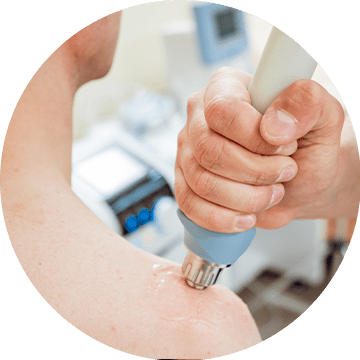

There are many causes of shoulder pain, like deterioration, inflammation, and trauma. Of the many painful shoulder conditions affecting Americans yearly, rotator cuff tendonitis and arthritis are very common. Also called calcific tendinitis, rotator cuff pain is caused by built-up calcium deposits on the shoulder's tendons, which connect your rotator cuff to nearby muscles and bones. This painful condition is usually linked to sports, like basketball and volleyball, or in professions requiring repetitive movements, like in the plumbing industry.
Some common symptoms of shoulder pain and rotator cuff tendinitis include:
Though strengthening exercises and some medications provide temporary relief for shoulder pain, they're not meant as long-term solutions. Luckily, Softwave therapy for rotator cuff pain in McClellanville, SC, can help.
Shockwave therapy has been shown to work wonders for shoulder pain. Low-intensity shockwaves break up calcium deposits and jumpstart your body's healing processes, stimulating blood flow and healthy cell growth. Shockwave treatment is especially effective for long-term shoulder pain since it releases stem cells, sends growth factors to the affected area, and boosts capillary production. Shockwave therapy has also been shown to break down scar tissue and eliminate trigger points, all of which decrease shoulder pain. This relief is most often long-lasting, unlike other treatments like medications and injections.
Many studies support the efficacy of Softwave therapy for shoulder conditions like rotator cuff pain and calcific tendonitis of the shoulder. In a study of 84 patients living with long-term rotator cuff tendonitis, participants in the treatment group saw a significant decrease in the intensity of their shoulder pain. Another study related to shockwave therapy for calcific tendonitis found that 86.6% of patients experienced fewer calcifications.
If you're having to live with rotator cuff pain or another type of shoulder issue, choosing Softwave therapy may be your best course of action.
Book AppointmentWhether you're sick of living with intense heel pain from plantar fasciitis, the mobility issues associated with knee pain, or the day-to-day struggles of rotator cuff degeneration, you'll find hope at Elite Healthcare Physical Medicine. Unlike some medical clinics, our team of doctors and specialists focus on an integrative, multidisciplinary approach to healing. Instead of relying on addictive medications and invasive surgeries, we prefer to address the underlying causes that our patients face.
We combine several all-natural pain relief therapies so that your shoulder pain, knee pain, joint pain, and foot pain go away for good. We resolve pain by using healing treatments that restore function and improve mobility for the long term. Our state-of-the-art regenerative medicine treatments, used hand-in-hand with proven chiropractic techniques, will stimulate your body's healing power from within. If your pain is related to muscles, nerves, and bones, our doctors can help you overcome discomfort, injury, or medical conditions affecting these systems.
If you've been unable to resolve your pain or have become dependent on painkillers to cope, Softwave therapy may be the natural solution you need. It all starts with a quick call to our office, so we can begin to understand your needs. When you come for your first visit, our doctors will find the personalized treatment you need so that you can manage your pain in a non-invasive and drug-free environment manner.
Book AppointmentLast fall, we urged Charleston County zoning officials not to allow a new sand mine operation on 20 acres next door to the St. James Santee Elementary-Middle School, and our call — along with the voices of several school officials and neighbors — was heard when the county deferred the request. Now that the proposal has returned in a slightly improved but still potentially harmful form, we repeat our request to reject the mining operation and urge others to do the same.We also repeat our call to state regulators to step up ...
Last fall, we urged Charleston County zoning officials not to allow a new sand mine operation on 20 acres next door to the St. James Santee Elementary-Middle School, and our call — along with the voices of several school officials and neighbors — was heard when the county deferred the request. Now that the proposal has returned in a slightly improved but still potentially harmful form, we repeat our request to reject the mining operation and urge others to do the same.
We also repeat our call to state regulators to step up efforts to bring South Carolina’s outdated mining laws up to date. This proposed sand mine is but one of many such operations that have triggered serious concerns about their impact on neighbors’ health and quality of life.
Charleston County’s Board of Zoning Appeals will meet at 4:30 p.m. Monday to consider a special exception for the sand mine off U.S. Highway 17 on a wooded tract just across Lofton Road from the St. James Santee school. While the request has been changed so that sand-laden dump trucks no longer would access U.S. 17 via Lofton, the operation still would create noise, vibration, dust and other problems for the school, which sits less than 1,000 feet away.
About 20 trucks are expected to come and go daily from the mining site, which is also about a half mile from the Francis Marion National Forest.
The county’s own analysis has suggested the mining site could mar land with soil types that the U.S. Department of Agriculture considers the best for agricultural production. The county’s comprehensive plan notes that “Designation of farmland preservation areas recognizes the importance of preserving Charleston County’s farming resources, including individual farms and areas of productive soils, as well as a way of life valued by the community,” and county staff says this mining use may not be consistent with the plan. The staff also notes its proximity to the school may make the mine harmful to the welfare and character of the immediate community.
The Coastal Conservation League’s Riley Egger tells us that while the new access road is a positive concession, “it does not alleviate our concern about the appropriateness of the mine site.” We urge others with similar concerns to email them to bza@charlestoncounty.org by noon Friday.
The looming controversy over a sand mine on Lofton Road points to a greater challenge that South Carolina must still grapple with: updating its mining law and regulations to make them appropriate for the 21st century, particularly as once-rural parts of our state are developing or being valued as conserved parks and lands. There are places where new mines are appropriate, but there are also places — such as neighborhoods, schools and public lands — that need to be protected from these new light industrial operations opening up next door. Our state isn’t the same largely rural place it was in the 1970s, when the current regulatory playing field for mining operations was designed.
The state Department of Health and Environmental Control has recently worked with a newly formed Mining Task Force, which includes mining companies and conservationists. We urge all involved to get back to the table and produce recommendations that lawmakers can consider next year. Our coastal communities are seeing how a growing demand for sand and fill leads to dusty highways, unwelcome discharges, blight and a scarred landscape with ponds of limited use. Berkeley, Charleston and Dorchester counties alone have had about 100 active sand mining operations in recent years.
Rejecting the Lofton Road sand mining proposal would be an important step to protect the St. James Santee Elementary and Middle School, but until the state updates its outdated mining law, such zoning controversies will continue to take up more of our time that could better be spent somewhere else.
Click here for more opinion content from The Post and Courier.
Known for its lovely weather, sandy beaches, and refreshing natural activities, South Carolina is an amazing state filled with particular towns featuring amazing historical, cultural, and natural sights. Aisles of delightful pastel-colored houses, mesmerizing waterfront views, and the delectable classic Southern supper shape the soul of these welcoming communities. The "Palmetto State" has settlements of all shapes and sizes, ...
Known for its lovely weather, sandy beaches, and refreshing natural activities, South Carolina is an amazing state filled with particular towns featuring amazing historical, cultural, and natural sights. Aisles of delightful pastel-colored houses, mesmerizing waterfront views, and the delectable classic Southern supper shape the soul of these welcoming communities. The "Palmetto State" has settlements of all shapes and sizes, from harbor towns to mountain hamlets to modern villages. If you seek a relaxing stroll through a green natural park, like Trailblazer Park in Travelers Rest, an adrenaline-rich paddleboarding adventure on Prestwood Lake near Hartsville, or a limitless Oktoberfest celebration in Walhalla, these unique South Carolina villages got you covered. So, take a moment to behold this all-American land laden with green natural scenery and festivals — South Carolina is waiting for you!
Turning your back to the Atlantic Ocean, McClellanville is where fishing, oystering, and shrimping are not just business but a way of life. The dense Francis Marion National Forest surrounds this small fishing town and grants a misty landscape usually found only in fairy tales. McClellanville has traditionally relied on the Atlantic Ocean and the coastal marshes for seafood provisions, which play a dominant role in the town's economy. The first store opened soon after the Civil War. Today, one can find many behind the ship masts. If one seeks to taste the fruit of the fishers' labor, T W Graham & Co provides a great selection of seafood dishes spanning from muscles to fried shrimps paired with scallops and french fries.
Travelers Rest enjoys the southern foothills of the Blue Ridge Mountains in South Carolina's magnificent Upcountry region. This cozy getaway once served as a hiding spot for the Lowcountry travelers who traveled through the highlands from the hot summer days. Those journeymen did not use highways but instead walked along iconic trails like the unique Bunched Arrowhead Heritage Preserve loop. Surrounded by the green forest, this trail still feels like a blast from the past, stepping where those journeymen once walked, and is popular with many tourists. Visitors to Travelers Rest can spend quality time at Trailblazer Park, where the green space is replete with fun attractions like a live music stage, food gazebos, car shows, and occasional movie projections.
Amidst the rolling hills and pastureland near the North Carolina border, Landrum boasts breathtaking natural wonders. Landrum ensures a warm and inviting atmosphere that will enhance your visit to this town. The nearby Chestnut Ridge Heritage Preserve provides many hiking trails, charming waterfalls, and stunning vistas belonging to story books. Spanning across Beaverdam Creek, the iconic Campbell's Covered Bridge with its red-colored wood goes in pendant with the fall foliage of the surrounding trees. Hikers will find the Palmetto Trail at the 575-acre Blue Wall Preserve very stimulating, with its scenic paths along Lanny's Falls past the twin ponds. Staying in town, downtown Landrum has plenty of artsy shops, boutiques, welcoming eateries, and antique shops like Landrum Eclectics, a Beautiful home full of antique and vintage pieces that warmly welcomes every customer.
York combines urban charm and small-town tranquility, where the nearby James Ross Wildlife Reservation forest quietly infiltrates the settlement. The town maintains a deep reverence for its history, which is showcased through its beautifully preserved historic district. One can admire the splendidly unique 19th-century buildings in the downtown area or explore one of the many museums. For example, the Museum of York County is a heritage museum that grants a naturalist center with hands-on programs and tells the story of York County. Moreover, York boasts a collection of historical landmarks highlighting its importance in American history. Among these is the McCelvey Center, an esteemed establishment listed on the National Register of Historic Places. The nearby Kings Mountain State Park provides the perfect setting for activities such as camping, hiking, or simply enjoying the natural heaven that surrounds you.
Walhalla overlooks the reaching shores of Lake Keowee near the Georgia border. Home to 4,072 hard-working people, Walhalla's community is known for its incredible natural scenery and its German heritage. German immigrants who sought refuge from the German revolutions of the mid-1800s settled here and named the town after "Valhalla" from Norse Mythology. Thanks to the prevalent German culture, the town also holds a massive annual Oktoberfest celebration with thousands of beer pints.
Besides the town's German history, there is a lot more to discover at places such as the Museum of Cherokee. This museum showcases South Carolina's Cherokee Native American heritage through artifacts, pottery, and texts. One of the most popular attractions is Issaqueena Falls, a beautiful rocky waterfall. The view of this amazing cascade is accessible only by its namesake trail and is one of the most unique sites to visit in the state! Visiting Walhalla will be just like entering the Nordic heaven.
Georgetown is the third oldest city in the state of South Carolina and the second-largest seaport. Part of what makes Georgetown unique is its beautiful historic homes, adorned with gracious porches, shaded, live-oak canopies, and sparkling waterways. Georgetown is easy on the eyes and provides distinct natural beauty. Georgetown has over 50 antebellum mansions in and around its downtown district, with some rumored to be haunted by ghosts, demons, and other entities. If you are into spooky tours, feel free to join the unique Ghosts of Georgetown lantern tour for a shivering experience through town.
For nature lovers, the Tom Yawkey Wildlife Center Heritage Center grants visitors an eye-watering 24,000 acres of pristine nature and hosts hundreds of animals, including American alligators and loggerhead sea turtles. Strolling along the town's scenic Harborwalk, one might find some of Georgetown's fine eateries. For example, Soco Grille delights customers with its juicy brisket and wide selection of seafood offerings.
Prestwood Lake bounds the small town of Hartsville, creating a fantastic ambiance. Hartsville combines a collection of cultural attractions and a wide range of natural wonders. When it comes to nature, Hartsville houses many gorgeous gardens and parks filled with scenic views, such as the Kalmia Gardens, which displays 30 acres of floral biodiversity and is a great place to start your Hartsville journey. Another must-see attraction is the Hartsville Museum, an old 1930s post office that has been repurposed into a home for history and art. This museum also boasts historical movie exhibits, a sculpture garden, and a mural featuring the town's first commercial studio. For outdoor lovers, the nearby Prestwood Lake grants 280 acres of water sports fun, a perfect setting for swimming, kayaking, or even paddleboarding. For a more relaxing experience, the Hartsville Memorial Library is a great place to relax and wind down. This library was established in 1920 and has hundreds of books on display, as well as magazines and even historic newspaper prints.
South Carolina is a stronghold of that unique old-school American charm, and its small towns are proof that pairing natural beauty with historical legacy is an excellent match. From the small fishing town of McClellanville with its ever-crowded port to the splendidly restored 19th-century buildings in downtown York or the sweeping Tom Yawkey Wildlife Center Heritage Center with its free wildlife near Georgetown, South Carolina's communities are eager to show their peculiarity and charm with travelers of all origins. Each of these towns serves as a refuge of curiosities and provides a peaceful ambiance in their unique way.
It has now been 34 years since Hurricane Hugo devastated much of the coast of South Carolina.What You Need To Know Hugo was a Category 4 hurricane with estimated sustained winds up to 140 mph when it came inland during the early morning hours of Sept. 22, 1989, near McClellanville, S.C.Hugo produced a 16-foot ...
It has now been 34 years since Hurricane Hugo devastated much of the coast of South Carolina.
Hugo was a Category 4 hurricane with estimated sustained winds up to 140 mph when it came inland during the early morning hours of Sept. 22, 1989, near McClellanville, S.C.
Hugo produced a 16-foot storm surge in McClellanville. A high school in the small coastal town had been selected as a shelter because maps showed it was at an elevation of 20 feet. It was actually just 10 feet above sea level, and six feet of seawater rushed into the school, where around 400 people were seeking shelter.
Eyewitness accounts say people became trapped and climbed on top of tables and chairs to avoid drowning.
Wind gusts up to 108 mph occurred in nearby Charleston, damaging around 80% of roofs in the city. Over 100 buildings in Charleston were severely damaged or destroyed.
Along the North Carolina coast, Hugo damaged at least 25 beachfront homes at Holden Beach and completely washed away seven to eight-foot dunes. The storm also destroyed a 50-foot section of the Carolina Beach pier.
Hugo did not only impact coastal areas. The storm produced hurricane-force winds as it moved over Charlotte.
Wind gusts in the Queen City reached up to 100 mph. Around 85% of the city lost power. Windows from skyscrapers in Uptown were blown out and came crashing down on nearby streets.
Hickory reported a gust of 85 mph.
There were numerous downed trees and widespread power outages across the western Piedmont and Foothills of North Carolina.
Heavy rain led to flash flooding in the northern mountains. Mount Mitchell recorded over 8 inches of rain from the storm.
According to the State Climate Office of North Carolina, seven to 12 deaths were attributed to the storm in North Carolina. That included a 6-month old child in Union County who was sleeping when a tree fell on his home.
Our team of meteorologists dives deep into the science of weather and breaks down timely weather data and information. To view more weather and climate stories, check out our weather blogs section.
Anglers and fish alike can enjoy an expanded CCA-McClellanville Reef (PA-34) as of this week.On Tuesday, March 9, South Carolina Department of Natural Resources (SCDNR) and Coastal Conservation Association South Carolina (CCA SC) staff took advantage of calm seas and beautiful weather to add a retired tugboat and 24 four-foot diameter concrete culvert pipes concrete culvert pipes to the existing artificial reef in 50 feet of water. The tugboat and culverts joi...
Anglers and fish alike can enjoy an expanded CCA-McClellanville Reef (PA-34) as of this week.
On Tuesday, March 9, South Carolina Department of Natural Resources (SCDNR) and Coastal Conservation Association South Carolina (CCA SC) staff took advantage of calm seas and beautiful weather to add a retired tugboat and 24 four-foot diameter concrete culvert pipes concrete culvert pipes to the existing artificial reef in 50 feet of water. The tugboat and culverts joined numerous other structures that form the reef, including remnants of the former Cooper River Bridge, concrete structures and a 105' tugboat. The new reef additions were funded in part by CCA SC and in part by funds provided through the purchase of saltwater fishing licenses. "The Coastal Conservation Association has been a tremendous help to us in getting high-quality material distributed along our coast," said SCDNR artificial reef coordinator Bob Martore. "Vessels like this provide an excellent foundation for a reef community because their complexity attracts a wide variety of species."
Artificial reefs play a similar role as coral reefs, which cannot grow in the temperate waters off the coast of South Carolina. These human-built structures are typically placed on areas of seafloor with little natural relief, improving habitat and spawning grounds for a diverse array of fish and marine life – and in turn attracting recreational divers and anglers.
"Today's deployment marks another fantastic collaborative effort between the conservation community, private industry, and state government that benefits both fish and fishermen" said Scott Whitaker, CCA SC executive director. "Enhancing habitat and expanding access for recreational anglers are two of the cornerstones in CCA SC's coastal initiative plan and we are excited about the additional projects planned for 2021 and beyond."
SCDNR has been constructing artificial reefs to improve offshore fish populations and recreational opportunities for over forty years, sinking everything from bridge spans to military vehicles to subway cars. The environmental benefits of artificial reefs are twofold, as they recycle materials that would otherwise be destined for landfills in addition to expanding critical habitat for offshore fish. Structures intended for artificial reefs undergo a long and rigorous cleaning process to ensure they're safe to sink.
South Carolina is home to dozens of artificial reef sites, the location data for which are free to download to your marine GPS device.
Lindsay is a working mother in McClellanville, South Carolina, and like many people living in rural communities, lacking access to reliable, high-speed internet used to be a challenge that affected her entire family.“Especially when the kids came home from school, and I was still working, I would have to be like, ‘nobody get on a tablet, nobody stream videos’… Even the kids had to wait to do their homework on their computers, because if there was one other device besides my computer using the internet, it woul...
Lindsay is a working mother in McClellanville, South Carolina, and like many people living in rural communities, lacking access to reliable, high-speed internet used to be a challenge that affected her entire family.
“Especially when the kids came home from school, and I was still working, I would have to be like, ‘nobody get on a tablet, nobody stream videos’… Even the kids had to wait to do their homework on their computers, because if there was one other device besides my computer using the internet, it would bring me down.”
It felt like an untenable way to live in the modern, connected world. That is until Home Telephone Company, with an assist from USDA Rural Development’s ReConnect Program, stepped in to extend high-speed internet services to several areas of Berkeley County, Dorchester County, and portions of the Greater Charleston area, of which McClellanville is included. And in Lindsay’s words, “It’s been a game-changer.”
“We have multiple devices, and everybody’s always running something. We’ve never had a glitch or interruption in service. It’s been beyond superior to what we had.”
Rural Development provided a $8,184,531 grant to fund the project. Home Telephone Company matched this funding for a total of $16,369,063. This enabled Home Telephone Company to extend fiber optic cable over 153 square miles, connecting 3,780 households, 19 educational facilities, eight critical community facilities, and families like Lindsay’s, to high-speed internet in the process.
Rural Development’s ReConnect Program furnishes loans and grants to provide funds for the costs of construction, improvement, or acquisition of facilities and equipment needed to provide high-speed internet service in eligible rural communities. Find out if ReConnect can do for your community what it did for the people in Orangeburg: https://www.usda.gov/reconnect.
Date of Obligation
Fri, 11/15/2019 - 16:05
Tue, 10/25/2022 - 10:41
Obligation Amount:
$8,184,531
Date of Obligation:
Congressional District:
Where can Iowans find some of the fastest internet service in Iowa? How about in three rural communities in the western part of the state that have a total population of just 962 residents. Residents in and around the communities of Breda (pop. 483) and Lidderdale (pop. 180)… [Read More]
